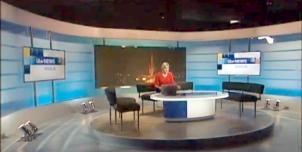Full Freeview on the Sudbury (Suffolk, England) transmitter
| Google Streetview | Google map | Bing map | Google Earth | 52.005,0.786 or 52°0'17"N 0°47'8"E | CO10 5NG |
The symbol shows the location of the Sudbury (Suffolk, England) transmitter which serves 440,000 homes. The bright green areas shown where the signal from this transmitter is strong, dark green areas are poorer signals. Those parts shown in yellow may have interference on the same frequency from other masts.
_______
Digital television services are broadcast on a multiplexes (or Mux) where many stations occupy a single broadcast frequency, as shown below.
64QAM 8K 3/4 27.1Mb/s DVB-T MPEG2
H/V: aerial position (horizontal or vertical)
The Sudbury (Suffolk, England) mast is a public service broadcasting (PSB) transmitter, it does not provide these commercial (COM) channels: .
If you want to watch these channels, your aerial must point to one of the 80 Full service Freeview transmitters. For more information see the will there ever be more services on the Freeview Light transmitters? page.
Which Freeview channels does the Sudbury transmitter broadcast?
If you have any kind of Freeview fault, follow this Freeview reset procedure first.Digital television services are broadcast on a multiplexes (or Mux) where many stations occupy a single broadcast frequency, as shown below.
64QAM 8K 3/4 27.1Mb/s DVB-T MPEG2
H/V: aerial position (horizontal or vertical)
The Sudbury (Suffolk, England) mast is a public service broadcasting (PSB) transmitter, it does not provide these commercial (COM) channels: .
If you want to watch these channels, your aerial must point to one of the 80 Full service Freeview transmitters. For more information see the will there ever be more services on the Freeview Light transmitters? page.
Which BBC and ITV regional news can I watch from the Sudbury transmitter?

BBC Look East (East) 0.8m homes 3.2%
from Norwich NR2 1BH, 77km north-northeast (24°)
to BBC East region - 27 masts.
70% of BBC East (East) and BBC East (West) is shared output

ITV Anglia News 0.8m homes 3.2%
from NORWICH NR1 3JG, 78km north-northeast (24°)
to ITV Anglia (East) region - 26 masts.
All of lunch, weekend and 80% evening news is shared with Anglia (West)
Are there any self-help relays?
| Felixstowe West | Transposer | 1000 homes +1000 or more homes due to expansion of affected area? | |
| Witham | Transposer | 14 km NE Chelmsford. | 118 homes |
How will the Sudbury (Suffolk, England) transmission frequencies change over time?
| 1984-97 | 1997-98 | 1998-2011 | 2011-13 | 1 Aug 2018 | |||||
| B E T | B E T | B E T | E T | K T | |||||
| C29 | SDN | ||||||||
| C31 | ArqA | ||||||||
| C35 | C5waves | C5waves | |||||||
| C37 | ArqB | ||||||||
| C41 | ITVwaves | ITVwaves | ITVwaves | D3+4 | D3+4 | ||||
| C44 | BBC2waves | BBC2waves | BBC2waves | BBCA | BBCA | ||||
| C47 | C4waves | C4waves | C4waves | BBCB | BBCB | ||||
| C51tv_off | BBC1waves | BBC1waves | BBC1waves | ||||||
| C56tv_off | ArqB | ||||||||
| C58tv_off | SDN | ||||||||
| C60tv_off | -ArqA |
tv_off Being removed from Freeview (for 5G use) after November 2020 / June 2022 - more
Table shows multiplexes names see this article;
green background for transmission frequencies
Notes: + and - denote 166kHz offset; aerial group are shown as A B C/D E K W T
waves denotes analogue; digital switchover was 6 Jul 11 and 20 Jul 11.
How do the old analogue and currrent digital signal levels compare?
| Analogue 1-4 | 250kW | |
| SDN, ARQA, ARQB, BBCA, D3+4, BBCB | (-4dB) 100kW | |
| Analogue 5 | (-7dB) 50kW | |
| Mux 2* | (-14.9dB) 8.1kW | |
| Mux B* | (-15.2dB) 7.5kW | |
| Mux 1* | (-15.5dB) 7kW | |
| Mux A* | (-17dB) 5kW | |
| Mux C* | (-22.2dB) 1.5kW | |
| Mux D* | (-23.6dB) 1.1kW |
Which companies have run the Channel 3 services in the Sudbury transmitter area
|
|
Friday, 31 August 2018
Hi Hardy, it is built and I am pleased.
On a 12 ft pole in the garden I had a single set of 8 group B directors, my squashed group A J Beam square dipole, no reflector. In broad terms, channel 29 right up to channel 44 showed 60% for signal quality and strength.
I have added 4 extra rows of directors and a mesh reflector behind. Signal strength on 29 near 90%, quality 75% On channel 44, less marked improvement, strength 68%, quality 75%
I cannot test channel 47 as it does not show on my set top box.
I am puzzled that the increase is greater on 29 as this is basically a group B aerial
No amplifier in line.
I have no idea how to tune a reflector so will leave the square grid.
Overall this is far superior to my my factory shallow x aerial
| link to this comment |
H
Hardy12:34 PM
That's good news Nick . I think that the addition of the reflector gave the main boost to the gain and made the dipole a better match. Not convinced that so many sets of directors relatively close together give much improvement but it works well . So cant knock it! We are getting warm weather again so any interference due to high pressure will be a good test.
| link to this comment |
Hardy, many years ago when we had analogue and no way of knowing with any readings whether the signal was improved or worsened, I held an extra string of directors against a J Beam with only one. The picture improved, so I added two. Without doubt, extra directors above and below are more beneficial than one string of 16. This is the principle of tri booms.
Because my dipole is now 12 inches high, with the top and bottom strings two inches above and below that, the strings are 4 inches apart, and angled so that at the front they are six inches apart.
My reflector is 6 inches away. Maybe it should be closer, but as I do not know how to find the impedance of the dipole, I have settled on that as the directors may well have reduced it below 75 ohms.
I wish I knew how to make a similar one for wi fi, but no idea how to match the dipole.
| link to this comment |
Hardy
do you remember the J Beams with 'wiggly' directors? They were in the form of 4 arms, the bottom part at 45 degrees, the top horizontal.
Group a had very large 'arms', c/d small. How do you square this with the shallow x's with their short arms which apparently make them wideband? If short arms do this, then all those old J beams would have had the same length short arms!
| link to this comment |
H
Hardy8:57 PM
Z beams need to be long in A group ,short at CD . Just like standard Yagis. They were not As broadband as X so were fairly evenly spaced . You might notice that X directors are closer together near the dipole to control the overall aerial bandwidth. Thick or x elements can be around 0.8 as long as equivalent thin elements.
I was an electronics technician . College courses were in telecommunications and radio.
looking at the gain diagrams of the various types if aerial on that aerial website I listed is very educational.
| link to this comment |
Saturday, 1 September 2018
N
nmugford11:39 AM
hi,nick,i think strict impedance matching isnt required,most domestic equipment is loosely coupled,but i would try changing the ali dipole for a copper wire ,i changed a set top to same and got a locked picture at 45 miles from hannington at ground level,the aluminiun wouldnt supply enough for a locked picture.What were the benefits signal wise of the bbc X?
| link to this comment |
H
Hardy2:30 PM
The old large X in analogue days was no better than an H . THey were just cheaper to make . A bit of a gimmick rather like tri beam aerials are today. The only advantage was that some versions of the X could reduce unwanted reception at 90 degrees from the wanted direction.
| link to this comment |
Sunday, 2 September 2018
N
nmugford9:32 PM
to hardy,tks for the explanation,if i made a version for 27mhz what sort of radiation pattern horizontally?
| link to this comment |
N
nmugford9:37 PM
hi hardy,i remember now,i lived in swindon and some parts had chronic multi path,so the X might have helpful,ta nick
| link to this comment |
Select more comments
Your comment please!




